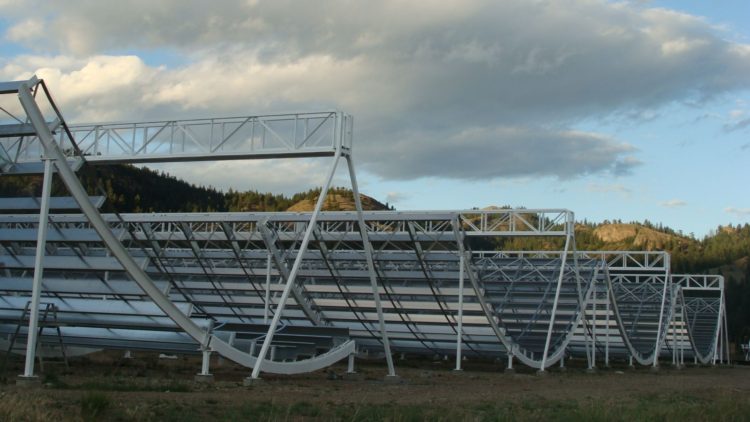By Aaron Miller-
Canadian scientists claim to have discovered a mysterious radio signal emanating from a galaxy far, far away has been detected by a telescope in British Columbia. The discovery is being hailed as significant because of its rarity of occurrence. It is only the second time ever a repeating signal has been observed by scientists. The causal element of the FRBs is baffling scientists. Some are even exploring the possibility that a neutron star is releasing powerful signals after it exploded or even, albeit held by only a small minority, that they’re signals from an alien civilisation.
It depicts fast radio bursts without being able to identify the source. At the winter meeting of the American Astronomical Society this week, researchers at a powerful new Canadian telescope said they detected 13 new fast radio bursts (FRBs) after close two months of observations. The discovery is said to be 20-per-cent higher than the five dozen bursts found in the past 12 years.
One of the newly detected bursts is a rare “repeater” , researchers liaising closely with a number of publications including gizmodo.com and Nasa told some of our keen observers with an eye of the unthinkable. Space is an amazing thing , and word travels fast in today’s brilliant and highly integrated world. ”We saw six flashes coming from the same spot in the sky, one scientists told The Eye Of Media.Com, whispering the information as though bewitched t by the experience of revealing a secret already leaked to a few others. There is definitely some crazy life out there, it’s not a joke, he said .
News of strange radio signals have occurred before in the past, they are not new. There are only new forms of experiences which makes those who experience wonder whether something strange is going on in the realms above, trying to communicate through some strange code to humans. Despite these odd discoveries that occasionally leak out, we rarely ever get an official announcement or confirmation directly from a governmental source. We ask why, and all sorts of indecisive answers emerge.
SOURCE
”The exact source of these signals need to be identified before anything can really be made official. Without that they say it is just speculation, but believe me , something strange is happening in the higher realms, said a man vetted by respected writers and researchers from gizmodo.com as a scientist . There is an attempt to pass a message down, it’s real! Only one other repeating FRB has ever been found. before now. The claim of strange radio signals being spotted is far from fictional and has been confirmed from a few reliable sources, but there still seems to be a sense of secrecy and careful treading about it.
“These things are coming to us from halfway across the universe and we don’t really know anything about them,” said McGill University’s Shriharsh Tendulkar, a lead author of one of two papers in the journal Nature about the new findings. “Isn’t that exciting?” The cylindrical instrument, which maps a 3-degree-wide swath of the sky every night, was already a dramatic improvement on more traditional telescopes, which can only focus on a single spot.
Scientists on the project have hinted that at least 100 more bursts will be reported in the weeks to come.
“With fast radio bursts, it’s always felt like the more answers we get, the more questions we have,” said Sarah Burke-Spolaor, an astrophysicist at West Virginia University who was not involved in the new research. “But I think we’re reaching the peak of that mountain.” Cornell University’s Shami Chatterjee, a fellow FRB researcher, agreed: “This field is about to break wide open.”
The signals are reportedly so transient, making their source of origin ever so mysterious. They reveal high frequency wavelengths, indicating they they travel long distances across wide expanses of space that stretch them to astronomers’ radio dishes.
Scientists are split in their theory of the magnetic fields that produce these new stars, but say only one burst has ever been traced back to its source. The repeating burst called FRB 121102, which flickers periodically from a dim dwarf galaxy 3 billion light-years away.
The repeater detected by CHIME bears a strong resemblance to FRB 121102, said Dunlap Institute astrophysicist Cherry Ng, lead author of the second Nature paper. Both have what Ng calls “structure” – distinctive patterns in the timing and frequency of the signals.
The CHIME researchers are working with an array of antennas in central New Mexico to track down the source of the galaxy from which the second repeater emanates. They are optimistic that its repetitive feature will increase their chances of tracing the radio signal again.
But that’s just one of the riddles associated with this “fantastic phenomenon,” said Tendulkar. Scientists are still debating whether repeating FRBs come from the same source as the one-time flashes, or instead represent a distinct type of event. They don’t know whether the bursts are like flashbulbs, lighting up the sky in every direction, or focused beams, which would require less energy but must be more frequent for Earth to see so many of them.
Image: Gizmodo.Com

